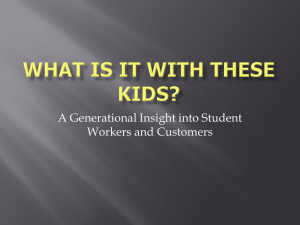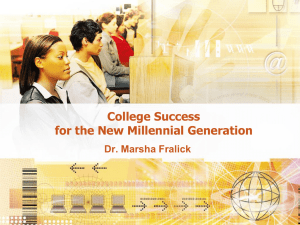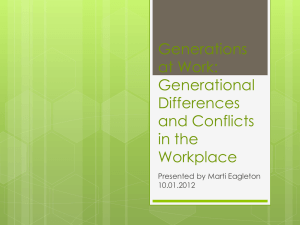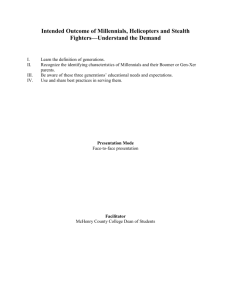An Examination of Millennials` Use of Structure in
advertisement
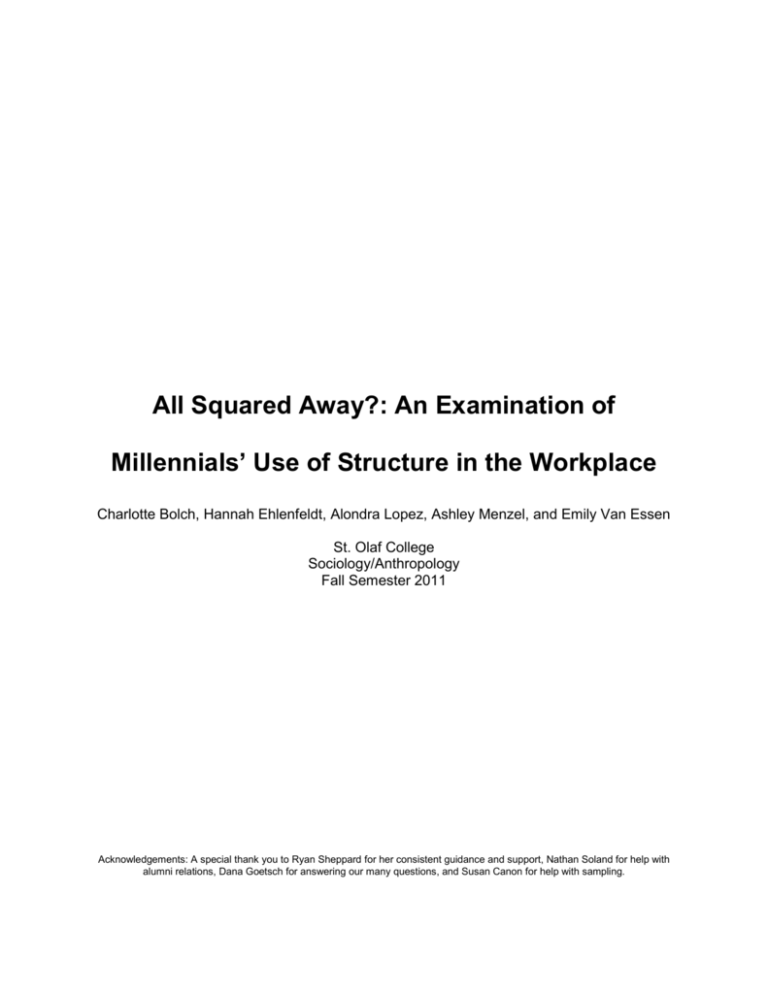
All Squared Away?: An Examination of Millennials’ Use of Structure in the Workplace Charlotte Bolch, Hannah Ehlenfeldt, Alondra Lopez, Ashley Menzel, and Emily Van Essen St. Olaf College Sociology/Anthropology Fall Semester 2011 Acknowledgements: A special thank you to Ryan Sheppard for her consistent guidance and support, Nathan Soland for help with alumni relations, Dana Goetsch for answering our many questions, and Susan Canon for help with sampling. Abstract Recent literature suggests Millennials—people born after 1980—prefer a more structured work environment compared to Generation X and Baby Boomers, and this may cause intergenerational tension in the workplace. To investigate this dynamic further, we analyzed the use and perceptions of structure-providing items such as calendars and checklists. We surveyed a random sample of undergraduates and alumni from a small liberal arts college in the Midwest and tested the hypotheses: 1) Millennials prefer more structure in the workplace compared to Generation X and Baby Boomers; 2) Generation X and Baby Boomers perceive Millennials as needing more structure in the workplace compared to what Millennial students and Millennials in the workplace believe they need. Review of Literature A new generation of young workers is entering the workplace and piquing the interest of society and social scientists. This generation is the Millennials. Born after 1980, Millennials are the most recent group to join today’s workforce (Taylor and Keeter 2010). Although Millennials are strictly defined by the period in which they were born (Smola and Sutton 2002), they share similar characteristics and values. As a generation, Millennials are characterized as team oriented, multitasking, entitled, optimistic, and civic minded. They seek work-life balance and career advancement (Alsop 2008). As Millennials start to enter the workplace, supervisors and executives are looking to see how they will interact with older generations. These older generations include Generation X, known as GenXers, and Baby Boomers. Baby Boomers, born between 1946 and 1964, (Taylor and Keeter 2010) are seen as workaholics and idealists who are competitive and loyal (Alsop 2008). Boomers are the parents of Millennials, as well as the ones who are currently hiring them into the workforce. GenXers were born between 1965 and 1980 (Taylor and Keeter 2010); literature characterizes them as self-reliant, adaptable, cynical, distrusting of authority, resourceful, and entrepreneurial (Alsop 2008). The presence of Millennials, GenXers, and Baby Boomers in the same work environment is causing intergenerational relations to become a hot topic of research and discussion. This is a relatively new area of study and researchers are investigating topics such as social responsibility (Taylor and Keeter 2010; Twenge, Campbell, Hoffman, and Lance 2 2010), helicopter parents (Gardner 2007; Eisner 2005), need for feedback, need for structure, work-life balance (Cennamo and Gardner 2008; Ng, Schweitzer, and Lyons 2010; Myers and Sadaghiani 2010), technology (Barzilai-Nahon and Mason 2010; Judd and Kennedy 2011; Taylor and Keeter 2010; Westlake 2008), and hiring, promotion, and progress (Dries, Pepermans, and De Kerpel 2008; De Hauw and De Vos 2010; Kowske, Rasch, and Wiley 2010). Our research will focus specifically on Millennials and structure. Popular literature claims Millennials prefer a work environment that provides explicit direction, consensus, and feedback. They often struggle with critical-thinking and ambiguity, and they hesitate to take risks. Millennials may rise to the occasion, but they need things like checklists, mentoring, and clear goals in order to reach their potential (Alsop 2008). This is the conception of structure that our study will focus on when examining Millennials’ “need for structure”. As Millennials start to work alongside older generations of GenXers and Baby Boomers, this need for structure has become a persistent source of tension. Alsop noted business managers often feel as though Millennials need more “hand holding,” and Millennials have trouble taking responsibility for projects. Executives fear this will jeopardize Millennials’ ability to become effective leaders and thrive within a changing work environment. In response, some business schools have tried to challenge students with open-ended problem solving (2008). It remains to be seen whether their efforts will translate to the workplace. Influence of Education on Millennial Preferences and Expectations Millennials are on track to be one of the most highly educated and tech-oriented generations in history. Advancement in technology has allowed them to connect to the world 24/7, and they view technology as an integral part of their educational and personal lives. While some critics believe this has led Millennials to become entitled, coddled, lazy, and rude (Claps 2008), researchers largely agree that things like government programs and parental guidance have accustomed Millennials to living and learning in a structured environment. This has led Millennials to use structure as a critical tool for success. 3 In 1983, parent-initiated educational reform led to a demand for higher literacy rates and standardized test scores. This caused an increase in the regulation of school curricula, initiating the “teach to the test” phenomenon where teachers’ syllabi are directly linked to subjects that will be on standardized tests (Hershatter and Epstein 2010). This change in classroom structure has prompted Millennials’ reliance on guidelines and deadlines. Alsop observes the similar need for guidelines in the college setting. College professors note that their students seek clarity and detail in their course assignments and complain about ambiguous instructions or expectations (2008). This aversion to ambiguity carries over into the workplace after students graduate. One of the main issues employers may face in working with Millennials is role ambiguity, defined as the lack of clear role expectation. Results from a study on Millennial workers with retail experience indicated that role ambiguity negatively affected job satisfaction (Kim, Knight, and Crutsinger 2009). Millennials have developed an expectation of acknowledgement for their accomplishments that stems from loving parents and dependence on detailed guidance by their educators (Hershatter and Epstein 2010). Students have become more self-confident; this confidence, in turn, has led to an increase in self-esteem and narcissism. This self-perception is one of the reasons why employees have extremely high expectations for both themselves and the company (Twenge and Campbell 2008; Merlino 2008). With this rise of high expectations in the workplace, Twenge and Campbell state that self-evaluations will become less useful and over-reward people who are confident rather than competent (2008). Managers in the workplace will need to decide how to manage these Millennials that see themselves as superior and rate themselves higher on performance. Group projects and presentations are frequently assigned by teachers in school and have become valued by Millennials in the workplace (Ng et. al. 2010). The interactions that occur during these group tasks help create and maintain relationships amongst organization members; without well-maintained relationships lower productivity may result (Myers and 4 Sadaghiani 2010). According to popular literature, Millennials prefer working in groups because it makes work more pleasurable and distributes responsibility (Alsop 2008). Additionally, Alsop suggests Millennials enjoy working in groups because they dislike taking risks (2008). This comfort in group work could also be related to the familiarity in the style of assignment--similar to their school days. With the extra practice of group work during the school year, Millennials, when compared to previous generations, are more comfortable in this type of situation (Myers and Sadaghiani 2010). Millennials as Collaborators Millennials fear risk-taking and struggle when managers assign projects that do not have explicit instructions or well-defined criteria (Claps 2008, Hershatter and Epstein 2010). They value consensus and prefer to work in teams that can provide support; as a generation, the Millennials are the “great collaborators” (Lancaster and Stillman 2010). A study done in Australia even suggested Millennials may be more motivated when they work in an atmosphere that includes personal interaction (Wong, Gardiner, Lang, and Coulon. 2008). Because of this affinity for group work, some employers question this generation’s ability to become effective leaders (Alsop 2008). Millennials have been coached all of their lives, and they expect the same in the workplace (Lancaster and Stillman 2010). They desire close relationships with supervisors and expect feedback and open communication. Millennials grew up with friendship-style parenting, and as result, they feel comfortable forming friendships with other adults (Myers and Sadaghiani 2010, Ng et. al. 2010). Bransford found Millennials preferred charismatic and servant leadership to ideological and pragmatic leadership styles. This suggests they value executives that promote individual and group goals or that embody an example to imitate (2011). Other studies have noted GenXers feel that Millennials are in search of role models and look to managers/supervisors for knowledge (Gursoy, Maler, and Chi 2008). Increasing contact and building relationships between younger and older generations can lead to a decrease in tension 5 between these two groups as well as more positive attitudes (2008). However, mentors that use coaching strategies must be wary of nagging their employees or of falling into the trap of acting like their parents (Lancaster and Stillman 2010). While coaching can help Millennials adapt to the workplace, “parenting” can blur boundaries and become a burden for both parties. Workplace Policies and Evaluations Millennials struggle to find a balance or middle ground between structure and flexibility. In order to find a middle ground between flexibility and structure, managers must let Millennials feel a sense of autonomy but clearly communicate objectives of the work that needs to be done (Gursoy et. al. 2008, Kim et. al. 2009). For Millennials, this middle ground could be policies that provide organization but that also leave room for development. Millennials experience stress and tension when they feel they lack information about their expectations (Kim et. al. 2009). For executives and managers, this middle ground could be policies that keep Millennials on track but leave room for some autonomy and creativity. With too much direction, businesses face the danger of stifling the ingenuity of the younger generation (Alsop 2008). Some organizations are implementing top-down strategies in which executives dictate the boundaries, goals, and outcomes of work projects (Barzilai-Nahon and Mason 2010). While this seems it would provide the structure that Millennials desire, management literature indicates that top-down strategies may be ineffective in the long run because they can alienate younger employees (Pascale and Sternin 2005). Instead, executives might try to nurture autonomy by defining goals and judging by results rather than micro-managing every step (Barzilai-Nahon and Mason 2010). Supervisors are able to accommodate Millennials’ desire for clear objectives through work evaluations and through assessing how the employee fits into the company (Myers and Sadaghiani 2010). Evaluations are one way supervisors are able to keep open communication with their Millennial employees, something Millennials value in the workplace (2010). Millennials can then use these evaluations as a guideline for expected work behavior. According to Alsop, if the evaluation is negative, the supervisor should be careful presenting it, as Millennials are 6 fragile and may get emotional. Millennials are also considered to be goal-oriented and may take a negative evaluation as a “goal” to overcome (2008). Although many studies relate to Millennials’ need for structure, minimal research exists specifically on this work-structure phenomenon. Using popular ideas about how Millennials relate to structure, we constructed an empirical study that surveyed current students and alumni from a small liberal arts college in rural Minnesota. Our research examines what kind of structure-providing items generations feel are important in organizing their time at work and the perceptions of Millennials’ need for structure in the workplace. Methods We conducted survey research during November of 2011 that examined a random sample of Generation X, Baby Boomer, and Millennial alumni from a private liberal arts college in the Midwest, as well as current junior and senior Millennial students. Survey research enabled us to reach a relatively large population and conduct research within a limited time frame. This method was cost-effective and efficient, and responses were easy to code for analysis. We investigated the following hypotheses: 1) Millennials prefer more structure in the workplace compared to Generation X and Baby Boomers; 2) Generation X and Baby Boomers perceive Millennials as needing more structure in the workplace compared to what Millennial students and Millennials in the workplace report themselves as needing. We created an online survey using the program Form Creator. This program provided a template of a survey design that enabled us to input headings, directions, questions, and response categories related to our topic. This Form Creator survey allowed us to view the responses of our participants without being able to connect names to the specific responses. Fellow researchers from our Sociology/Anthropology Research Methods class, who also examined Millennial habits in relation to the workplace, combined their survey questions with ours to create an overall survey about structure, feedback, and personal communication. We sent a cover letter with login information to access the survey online to the following three 7 groups: current junior and senior Millennial students, recent Millennial alumni in the workplace, and GenXers/Boomers. Variables For all three hypotheses, we examined differences between GenXers/Boomers and Millennials. Because we examined the differences across generations, the independent variable was the generational category. We determined this from the demographic section of our survey where we asked respondents their class graduation year or current student status. We inferred age from graduation year and then categorized these responses according to the age ranges that we defined for each generation, as previously defined in our literature review. Our independent variables were therefore nominal variables because they measured something that was discrete and representative of a classification (Nardi 2006). For our first hypothesis—that Millennials use more structure in the workplace compared to Generation X and Baby Boomers—our dependent variable was use of structure. We define structure as the structure/organizational items used to organize daily life such as calendars/planners, checklists, and post-it notes and assistance with work tasks. To measure this variable, we asked all generations to respond to a series of Likert-scale statements. We used the following response categories for each statement: “Strongly Agree,” “Somewhat Agree,” “Somewhat Disagree,” and “Strongly Disagree.” An example of one of the three statements is, “Using a calendar/planner (electronic or paper) is important for organizing my work tasks.” This dependent variable was an ordinal measure because each value increased in equal segments (Nardi 2006). Because these Likert-scale statements appeared on all three of the surveys, we were able to compare the self-reported use of structure between each generational category. For our second hypothesis—Generation X and Baby Boomers perceive Millennials as needing more structure in the workplace compared to what Millennial students and Millennials in the workplace believe they need—our dependent variable was perception of preference for 8 structure. We created an index composed of a series of five Likert-scale statements in order to measure this variable. An index is a series of similar statements that measure a unified concept (Nardi 2006). We used the same response categories as in the questions about use of structure. Our statements examined multiple aspects of Millennial use of guidance in workplace situations. These included statements like, “Using my calendar or planner is important for organizing my work tasks” and “I need an outline of job expectations.” We then coded these responses into an index score by adding together all the responses on each question to create an interval/ratio measurement. Because we did not reverse word any of our statements there was no reason to reverse code our variables. In addition to our index, we asked two questions about group work designed to measure Millennial preference for structure. Because we still used the same four response categories (“Strongly Agree” to “Strongly Disagree”) these questions were ordinal measures. Validity We tried to achieve validity by ensuring that our measures were accurate and asked about the key components of the research topic (Nardi 2006). The two main ways we assessed measurement validity were face validity and content validity. To achieve face validity—that the measures appear to be eliciting what we desire them to—we analyzed our questions, asking ourselves and an experienced researcher whether it appeared our measures would yield the kind of opinions and behaviors we were seeking to explore. To achieve content validity— assuring that all aspects of our conceptual definition were measured—we asked ourselves whether our questions covered the different dimensions of structure we identified. We used feedback from our peer focus groups, from informal interviews with GenXers and Boomers, and from an experienced researcher, enabling us to construct accurate measures. They provided us with feedback on whether our questions were clear and understandable and gave us advice for improving our questions. Conducting a focus group allowed us to refine our questions and to target specific attitudes or behaviors of Millennials and GenXers/Boomers regarding use of 9 structure in the workplace. Reliability Reliability refers to consistent, similar results that should occur if the same measure is used again in the future (Nardi 2006). We promoted reliability in several ways: using specific and clear conceptual definitions and ensuring that all statements were mutually exclusive and exhaustive. We constructed a definition of structure consisting of two parts: 1) the structureproviding items used to organize daily life such as calendars/planners, checklists, and post-it notes and 2) assistance and deadline reminders used to complete a task. We established this definition with the help of focus group input on what participants considered as structureproviding items and what they needed in the form of structure to complete a task. By constructing a specific and clear definition of structure we ensured reliability. We also promoted reliability by using an index. An index compiles similar items within a questionnaire to see if parallel items yield similar results (Nardi 2006). Examples of items from our GenXer/Boomer index included: “Millennials need an outline of job expectations” and “Millennials need to be reminded of deadlines.” If many participants responded to both statements with “Strongly Agree”, this would indicate that GenXers/Boomers perceive Millennials as using more structure in the workplace. To insure consistent, comparable results from our three random samples, we made sure our survey questions used similar sentence structure. For example, we changed the wording in the Millennial surveys to read: “I need an outline of job expectations” and “I need to be reminded of deadlines.” Lastly, we safeguarded reliability by asking questions that have mutually exclusive and exhaustive response categories. We used the highest level of measurement possible by basing the answers to our survey statements on a four-point Likert scale. In striving to be exhaustive and mutually exclusive, each survey statement provided the following response categories: “Strongly Agree”, “Somewhat Agree”, “Somewhat Disagree”, or “Strongly Disagree”. We used four response options because too many options would require participants to make inaccurate 10 distinctions that would not be consistent across the sample population (Patten 2001). This list was exhaustive because it included all possible feelings about the statements, and it was mutually exclusive because participants’ views could not fit under more than one category (Nardi 2006). Therefore, we felt that a four-point scale was the most accurate way to measure our statements of varying attitudes and behaviors. We pre-tested our survey questions by talking to our focus group participants, interview respondents, and fellow researchers from our class. This information was used to change the wording of a few items in our survey, clarify directions, and tweak topic headings. Sampling and Sampling Procedure We drew samples from three target populations: junior and senior undergraduates at a private liberal arts college in the Midwest, GenXer and Boomer alumni between the graduation years 1964 and 2000, and Millennial alumni between the graduation years 2001 and 2011, excluding those who listed their occupation as volunteer, homemaker, military service, unemployed, or retired. Since the sample was relatively homogeneous, the preferences and the attitudes we measured were likely to occur in our population. Therefore a relatively small sample size was sufficient to obtain a representative sample (Nardi 2006). However, our sample size needed to be large enough to compare our subgroups of GenXer/Boomer alumni, Millennial alumni, and current junior and senior students. With a sampling frame of roughly 1,500 junior and senior students, we applied the rule of thumb method to determine what our sample size should be for this group. For populations that are less than 1,000, the rule of thumb states that the sampling size should be 30 percent; therefore, we estimated that our target population should be approximately 25 to 30 percent of our overall population (Neuman 2007). Based on past surveys conducted by SO/AN 371 researchers the response rate was usually around 50 percent, so we chose to double the sample size. This works to ensure that our sample size is large enough to be representative of the population as a whole. We used simple random sampling so each member of the population had an equal chance of being selected which 11 enabled us to provide an accurate representation of the population (Patten 2001). Before we created our target population, we chose to exclude students participating in other surveys, students who participated in our focus group, part-time students, first year and sophomore students, students currently enrolled in our research methods class, and students currently studying abroad. The Director of Institutional Research at the college completed the sampling process for us. 849 GenXer/Boomer alumni, 513 Millennial alumni, and 648 students received an e-mail inviting them to participate in our research. GenXer/Boomers received the survey on November 3, 2011, Millennial alumni received the survey on November 1, 2011, and current students received the survey on November 8, 2011. Both alumni surveys closed on November 11, 2011, and the student survey closed on November 13, 2011. Participation in the survey was voluntary, and we provided incentives for students to increase our response rate. After completing the survey, student participants had the option to enter their name in a drawing for gift certificates to the school bookstore. We did not provide incentives for alumni, but we encouraged alumni to help current members of their alma mater. To try to increase the response rate, half way through our response period, we sent a reminder e-mail encouraging participation in our survey. 92 Millennial Alumni responded giving us a response rate of 17.9%; 27.2% male and 72.8% female. 257 students responded, giving us a response rate of 39.6%. Of the student respondents 44.7% were juniors and 53.7% were seniors; 29.6% male, 70% female, and 0.004% other. 126 GenXer/Boomer alumni responded, giving us a response rate of 14.8%. Of the respondents, 66.2% were members of the Baby Boomer generation and 33.9% were members of Generation X; 54% were male and 68% were female. Ethics According to the Institutional Review Board (IRB) at a small liberal arts college in the Midwest, research that deals with human subjects needs to follow important principles such as respect for persons, respect for privacy before, during, and after the survey, and obtaining 12 informed consent. The rules established by the IRB require that researchers ensure voluntary and informed participation and that researchers provide the appropriate protection for subjects (IRB 2004). In addition to ensuring voluntary and informed participation, we needed to get Type I IRB approval from the college. Type I approval requires that the main purpose of the project is to advance the knowledge and understanding of the investigator and other members of the college (IRB 2010). We will not be able to generalize our results to populations outside of the college because we limited our sample populations to the college’s community. One of our main ethical concerns was to ensure that respondent privacy was upheld. We did this by ensuring the identity of our respondents could not be linked to their answers. Although our research was not highly sensitive, we wanted to make sure that no respondent’s personal information would be made public. We guaranteed anonymity by using randomized, computer-generated sampling, and by excluding any questions that asked for explicit identifying information beyond what was necessary for our study. We never received the list of people in our sample only email aliases created by the director of the IRB. In the e-mails asking people to participate, we informed students and alumni that all of their responses would remain anonymous. With the incentive of prize drawings, we could not avoid learning the identities of the respondents who chose to participate in the drawing. However, in this situation we still had no way of linking any one student to a particular response. We also faced the ethical issue of ensuring that we received informed consent from all participants of our survey. Informed consent means that the participants volunteer to participate out of their own personal free will with full knowledge of what the survey entails (Nardi 2006). We sent a cover letter via e-mail to our samples informing them about our survey and asking them to participate. This included information about the length of the survey, the research topics, and the time and date of poster sessions when participants and the general public could learn about the results. In addition, we informed participants that logging into Form Creator indicated their consent to participate. None of our participants were under the age of 13 eighteen therefore they did not need to receive parental consent to participate in our survey. We informed them that there were no repercussions for people who did not wish to complete all or parts of the survey. This information allowed prospective participants to evaluate the personal risk associated with our survey, guaranteeing that they took part at their own free will. Lastly, there was the potential for emotional stress, even if unintentional, to occur as a result of questions asked in the survey. To reduce the potential stress, we gave participants introductory information about the research. We informed them that they were able to leave the survey whenever they wished; there was no obligation to complete the survey. In addition, we constructed questions that would hopefully not cause more stress than a participant would face in their daily life. Results To test our hypotheses of whether older generations and younger generations use structure differently in the workplace we conducted statistical analysis using a Chi-Square test and an ANOVA test. We hypothesized that Millennials prefer more structure in the workplace compared to GenXers/Boomers, and also that GenXers/Boomers perceive Millennials as needing more structure in the workplace compared to what Millennials believe they need. We also investigated descriptive univariate data of Millennials’ and GenXers/Boomers’ responses to our survey questions about group work versus individual work and about clarifying questions. Univariate Data Our univariate analysis examined Millennial Students’ expectation to ask clarifying questions and to receive outlines of job expectations, as well as their preference for working in groups or individually. We also examined GenXer/Boomer preference for employees to ask clarifying questions and their perception of Millennial preference for working in groups or individually. When asked if they prefer working in groups, Millennials are divided mainly between somewhat agree (43.4 %) and somewhat disagree (37.6%) but when asked if they prefer to 14 work alone, a majority agree (85.9 %) (Figures 1 and 2). The majority of GenXers/Boomers agree (78.8 %) that Millennials prefer to work in groups over working alone (69.5 %) (Figures 3 and 4). There is a gap between what Millennials report as their preference and what GenXer/Boomer believe Millennials prefer. Figure 1: Millennial Preference for Group Work (left) Figure 2: Millennial Preference for Work Alone (right) Figure 3: GenXer/Boomer Perception of Millennial Preference for Group Work (left) Figure 4: GenXer/Boomer Perception of Millennial Preference for Working Alone (right) According to our results, 85.5% of Millennials (students and alumni) expect to be able to ask clarifying questions in the workplace. 98.2% of GenXers/Boomers prefer that employees ask clarifying questions in the workplace (Figures 5 and 6). We found it interesting that no 15 GenXer/Boomer strongly disagreed when asked if they prefer employees to ask clarifying questions. Figure 5: Millennial Expectation to Ask Clarifying Questions (left) Figure 6: GenXer/Boomer Preference for Clarifying Questions (right) Bivariate Data Hypothesis 1: Millennials prefer more structure in the workplace compared to Generation X and Baby Boomers. In analyzing the results for our first hypothesis, we used a Chi-Square test of independence to examine the importance of using each of our structure-providing items (postits, checklists and calendars/planners) for GenXers/Boomers, Millennial Alumni, and Millennial Students. A Chi-Square test compared the importance of using post-it notes in organizing work tasks. After collapsing the four response categories into agree and disagree, a significant relationship was found (2(2)=6.430, p < 0.05) in the importance of using post-it notes. Millennial Alumni were more likely to agree that using post-its is important for organizing their work tasks (73.6%) than were Millennial Students (65.0%) and GenXers/Boomers (56.7%). Figure 7 illustrates the preference of all generations combined for the use of post-its in organizing work. 16 Figure 7: Use of Post-its A Chi-Square test of independence compared the importance of using checklists in organizing work tasks for GenXers/Boomers, Millennial Alumni and Millennial Students. No significant relationship was found (2(2)=2.541, p > 0.05). The importance of using checklists in organizing work tasks appears to be independent of generational category (see Figure 8). Figure 8: Use of Checklists A Chi-Square test of independence compared the importance of using calendars/planners in organizing work tasks for GenXers/Boomers, Millennial Alumni, and Millennial Students. No significant relationship was found (2(2)=2.726, p > 0.05). The importance of using calendars/planners in organizing work tasks appears to be independent of generational category (see Figure 9). 17 Figure 9: Use of Calendar/Planner Hypothesis 2: Generation X and Baby Boomers perceive Millennials as needing more structure in the workplace compared to what Millennial students and Millennials in the workplace believe they need. We analyzed descriptive statistics and found that our Need for Structure Index1 was normally distributed. Therefore, we used a one-way ANOVA to compare the mean scores of the Need for Structure Index for our three generational categories (GenXers/Boomers, Millennial Alumni, and Millennial Students). A significant difference was found (F(2,448)=19.833, p < 0.05). We used Tukey’s HSD to determine the nature of the differences between the different generations. The analysis revealed that there was a statistically significant difference between GenXers/Boomers, Millennial Alumni, and Millennial Students (all p-values < 0.05). The table below shows the mean differences of our Need for Structure Index for GenXers/Boomers, Millennial Alumni, and Millennial Students. For example, it compares the mean score for GenXers/Boomers to the mean score for both Millennial Alumni and Millennial Students. The results indicate that GenXers/Boomers perceive Millennial Students as needing more structure 1 We included five items in our index: expectation for job outlines, reminder of deadlines, assistance in starting work tasks, assistance in completing work tasks and asking many clarifying questions when working new projects. 18 than Millennial Students report themselves as needing. Millennial Students report themselves as needing more structure than Millennial Alumni report needing (Table 1). Table 1: Comparison Between Generations: Need for Structure Index Tukey HSD (J)Gen. Grouped Mean Std. Error Difference (IJ) GenXers/Boomers Millennial Alumni 2.174* .347 Millennial Students .853* .282 Millennial Alumni GenXers/Boomers -2.174* .347 Millennial Students -1.321* .297 Millennial Students GenXers/Boomers -.853* .282 Millennial Alumni 1.321* .297 *The mean difference is significant at the 0.05 level (I)Gen. Grouped Sig. .000 .007 .000 .000 .007 .000 Discussion We found no statistically significant difference in the importance of using calendars/planners or checklists between Millennials and GenXers/Boomers; therefore, hypothesis one was not fully supported. Our results showed that the majority of respondents, regardless of generation, stated that they either “strongly agree” or “somewhat agree” that these tools are important for organizing work tasks. These results indicate that Millennials prefer high levels of structure, which supports Merlino’s (2009) finding that Millennial business students express a preference for high levels of structure in a classroom setting. However, our results also suggest that the use of these structure-providing tools is important for both younger and older generations. In light of Alsop’s (2008) discussion of GenXers and Boomers being “helicopter parents”, we speculate that the similarity between importance of calendars/planners and checklists could be a result of parents needing to keep up with their children’s busy schedules. In structuring their children’s lives perhaps they also need to structure their own lives with calendars/planners and checklists. After we collapsed response categories to be “disagree” and “agree,” we did find significant difference in the importance of post-its use across 19 generations. We speculate that this may be due to a greater use of electronic post-it programs among the tech-savvy Millennial generation (Alsop 2008). For hypothesis two, we found significant differences across all three generational categories as indicated by the Need for Structure Index (five items: use of outlines, assistance with tasks, clarifying questions, and deadlines). When we compared the GenXer/Boomer perceptions of Millennials’ need for structure to Millennials’ reports of their own need for structure, we found GenXer/Boomers believed Millennials needed more structure than the Millennials reported needing. This conclusion aligns with prior claims that the older generations believe Millennials need a lot of guidance in the workplace (Alsop 2008, Hershatter and Epstein 2010). In comparing the results of the two Millennial categories, we found Millennial Alumni reported needing less structure than Millennial Students reported needing. We were not expecting to find a significant difference in the values of the Need for Structure Indexes of the two Millennial categories because they belong to the same generation. We speculate Millennial Students may report needing more structure because they are accustomed to a structured undergraduate experience (Merlino 2009) and because undergraduate “work” often involves studying for multiple classes and keeping track of extra-curricular activities. While Millennial Alumni may have a busy schedule, their work may be geared toward one or two larger goals. In addition, because Millennial Alumni already have work experience, they may not need as much assistance. For employers and students entering the workplace, the results from our univariate analysis may provide insight to how generations’ structural habits may affect the workplace. Our data indicate that a majority of Millennials expect to be able to ask clarifying questions and to receive an outline of job expectations, suggesting Millennial employees may be more comfortable and productive if employers provide these resources. This supports literature that discusses how Millennials desire clear objectives and experience stress when job expectations are unclear (Kim et. al. 2009, Myers and Sadaghiani 2010, Hershatter and Epstiein 2010). Our 20 results also indicate that while GenXers/Boomers believe that Millennials prefer working in groups over working individually, we found that a majority of Millennial Students typically enjoy working individually, whereas only half enjoy working in groups of two or more. Although not aligned with Millennial preferences, the GenXer/Boomer results align with popular literature claims that Millennials value collaboration and prefer group work (Alsop 2008). However, while this indicates Millennial preferences, this has no bearing on whether they work individually or in groups. We also found interesting results related to clarifying questions. Our findings indicated that a majority of our GenXer/Boomer sample preferred employees to ask clarifying questions. In addition, they indicated that they did not feel that Millennials ask more questions than necessary. These results contrasted with the feelings of one GenXer/Boomer informant who felt his Millennial employees were not taking enough initiative because they were asking too many clarifying questions. Millennial Students should also note a large majority of GenXers/Boomers preferred employees to ask clarifying questions. They should keep in mind, however, our survey did not indicate their job status and their direct feelings toward receiving clarifying questions. While we focused on generational difference, we feel it is important to note individual use of structure may vary as the individual ages and gains more experience. As employees become more familiar and confident in their daily tasks, they may no longer feel the need to rely on clarifying questions, outlines of job expectations, assistance in starting or completing tasks, or reminders of deadlines. Conclusion Our research examined the question: Do older generations and younger generations use structure differently in the workplace? Through our survey, we examined both the use of structure for GenXer/Boomer and Millennial generations and the perceived “need for structure” of the Millennial generation. 21 Our results most strongly supported our second hypothesis--that GenXers and Boomers perceive Millennials as needing more structure than Millennials report needing. GenXers/Boomers, Millennial Alumni, and Millennial Students were all significantly different from each other. GenXers/Boomers believed that Millennials needed more structure than Millennials reported needing, and Millennial Alumni reported needing less structure than Millennial Students reported needing. This suggests GenXers/Boomers see Millennials as needing more structure than Millennials believe they need, and this gap in understanding may lead to tension between generations in the workplace. Our first hypothesis was only partially supported. While we found a statistically significant difference across generations for the importance of using post-it notes, we did not find a statistically significant difference across generations for the importance of using a calendar/planner and checklists. Because the majority of our respondents agreed calendars/planners and checklists were important to organizing their work tasks, our results suggest generations are similar in some aspects of structure use; perhaps structure is important in the workplace across all generations. In light of our results, we would recommend employers consider providing extra structure for newly hired Millennials. Employers might create a company calendar with deadlines for large projects, provide post-it notes for employees, and set time aside for Millennials to ask clarifying questions when starting a new project. Because Claps (2008) and Hershatter & Epstein (2010) suggest Millennials fear risk-taking and often struggle when managers assign projects that do not have explicit instructions or well-defined criteria, we believe Millennials may be more productive if employers provide opportunities for extra structure in the workplace. We would also recommend that career advising centers may want to emphasize realistic expectations for the workplace. Although career advising centers may believe Millennial Students do not expect outlines of job expectations, our results indicate Millennial Students anticipate this type of structure in future jobs. 22 Our sample population--students and alumni from a small liberal arts college in the Midwest--limits our ability to generalize our results beyond students and alumni of this college. In addition, because our sample is college-educated, they are probably more likely to have white-collar jobs. Their occupation might affect how the respondents interact with Millennials, and their level of education might affect how they might read the questions. Our survey length may have discouraged people from taking the survey because of the time it would take to complete. Because we combined our survey with two other research groups, we had to limit the number of questions asked, which limited the depth of our examination. Future research could examine whether Millennials use more technology in structuring their work time than older generations. We believe that Millennials may be using more electronic-based structure than GenXers/Boomers. In addition, future studies could expand our inquiry into Millennial enjoyment of group work versus individual work. This may enable researchers to examine the effectiveness for both work methods. 23 REFERENCES Alsop, Ron. 2008. The Trophy Kids Grow Up: How the Millennial Generation is Shaking Up the Workplace. San Francisco, CA: Jossy-Bass. Baldonado, Arthur M. 2009. “Exploring Workplace Motivational and Managerial Factors Associated with Generation Y.” Dissertation Abstracts International Section A: Humanities and Social Sciences 69(8-A):1-98. Barzilai-Nahon, Karine and Robert M. Mason. 2010. “How Executives Perceive the Net Generation.” Information, Communication & Society 13(3): 396-418. Bransford, Alysia A. 2011. “Generations: The Dividing Line Between Preferences for Leadership Styles.” Master’s Dissertation, Department of Psychology, University of Texas, Arlington. Retrieved from ProQuest Dissertation & Theses Database, 1493630. Cennamo, Lucy and Dianne Gardner. 2008. “Generational Differences in Work Values, Outcomes, and Person-Organization Values Fit.” Journal of Managerial Psychology 23(8):891-906. Claps, Elizabeth. 2010. “The Millennial Generation and the Work Place.” Master’s Thesis, The School of Continuing Studies and of The Graduate School of Arts and Science, Georgetown University. Retrieved from ProQuest Dissertation & Theses Database, 1475422. Deal, Jenifer J., David G. Altman, and Steven G. Rogelberg. 2010. “Millennials at Work: What We Know and What We Need to Do (If Anything).” Journal of Business and Psychology 25(2): 191-199. Deeken, JoAnne, Paula L. Webb, and Virginia Taffurelli. 2008. "We are all Winners: Training Silents to Millennials to Work as a Team." The Serials Librarian 54(3-4): 211-216. De Hauw, Sara and Ans De Vos. 2010. “Millennials’ Career Perspective and Psychological Contract Expectations: Does the Recession Lead to Lowered Expectations?” Journal of Business Psychology 25(2):293-302. Dries, Nicky, Roland Pepermans, and Evelien De Kerpel. "Exploring Four Generations' Beliefs about Career: Is ‘satisfied’ the New ‘successful’?" Journal of Managerial Psychology 23.8 (2008): 907-28. Eisner, Susan P. 2005. “Managing Generation Y.” SAM Advanced Management Journal 70(4). Gardner, P. 2007. “Parent Involvement in the College Recruiting Process: To What Extent?” Collegiate Employment Research Institute Research Brief 2. Retrieved September 19, 2011 (http://www.ceri.msu.edu/ceri-publications/). Gursoy, Dogan, Thomas A. Maler, and Christina G Chi. 2008. “Generational Differences: An Examination of Work Values and Generational Gaps in the Hospitality Workforce.” 24 International Journal of Hospitality Management 27(3):448-458. Hershatter, Andrea and Molly Epstein. 2010. “Millennials and the World of Work: An Organization and Management Perspective.” Journal of Business Psychology 25:211223. Institutional Review Board 2010. “Who Needs to Review my Project?” Northfield, MN: St. Olaf College Institutional Review Board. Retrieved December 7, 2011 (http://www.stolaf.edu/academics/irb/Policy/WhoReviews.pdf). Judd, Terry and Gregor Kennedy. 2011. "Measurement and Evidence of Computer-Based Task Switching and Multitasking by ‘Net Generation’ Students." Computers & Education 56(3):625-625-631. Kim, HaeJung, Dee K. Knight, and Christy Crutsinger. 2009. “Generation Y Employees' Retail Work Experience: The Mediating Effect of Job Characteristics.” Journal of Business Research 62(5): 548-556. Kowske, Brenda J, Rena Rasch, and Jack Wiley. 2010. “Millennials’ (Lack of) Attitude Problem: An Empirical Examination of Generational Effects on Work Attitudes.” Journal of Business Psychology 25(2): 265-279. Lancaster, Lynne C. and David Stillman. 2010. The M-factor: How the Millennial Generation is Rocking the Workplace. New York, NY: HarperCollins. Merlino, Nancy. 2009. "Key Pedagogical Strategies for Millennial Generation Students in University Business Courses." Master’s Dissertation & Thesis, Department of Organizational Leadership, University of La Verne. Retrieved from ProQuest Dissertation & Theses Database, 3370198. Myers, Karen K. and Kamyab Sadaghiani. 2010. “Millennials in the Workplace: A Communication Perspective on Millennials’ Organizational Relationships and Performance.” Journal of Business Psychology 25: 225-238. Neuman, W. Lawrence. 2007. Basics of Social Research: Qualitative and Quantitative Approaches, 2nd ed. New York, NY: Allyn & Bacon. Ng, Eddy S.W, Linda Schweitzer, and Sean T. Lyons. 2010. “New Generation, Great Expectations: A Field Study of the Millennial Generation.” Journal of Business Psychology 5: 281-292. Pascale, R.T. and J. Sternin. 2005. “Your Company’s Secret Change Agents.” Harvard Business Review 83(5): 72-81. Taylor, Paul and Scott Keeter, eds. 2010. Millennials: A Portrait of Generation Next. Pew Research Center for the People and the Press. Retrieved September 14, 2011 from (http://pewsocialtrends.org/2010/02/24/millennials-confident-connected-open-tochange/). Twenge, Jean M. and Stacy M. Campbell. 2008. “Generation Differences in Psychological Traits 25 and their Impact on the Workplace.” Journal of Managerial Psychology 23(8):862-877. Twenge, Jean M., Stacy M. Campbell, Brian J. Hoffman, and Charles E. Lance. 2010. "Generational Differences in Work Values: Leisure and Extrinsic Values Increasing Social and Intrinsic Values Decreasing." Journal of Management 36(5):1117-1142. Westlake, EJ. 2008. “Friend Me If You Facebook: Generation Y and Performative Surveillance.” TDR: The Drama Review 52(4):21-40. Wong, Melissa, Elliroma Gardiner, Whitney Lang, and Leah Coulon. 2008. "Generational Differences in Personality and Motivation: Do they Exist and What are the Implications for the Workplace?" Journal of Managerial Psychology 23(8): 878-890. 26

